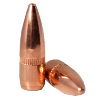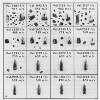The WaPo article is full of errors.
The major wounding mechanism of the M193 and M855 FMJ bullet is fragmentation, which happens when the bullet yaws. (The term "tumble" is inaccurate because it implies the bullet continuously flips end over end in the body, which it doesn't do.)
M193 and M855 FMJ are the most used cartridges in mass shootings because they're less expensive.
When the M193/M855 bullet (hereafter referred to as "M193" because both bullets behave the same way) impacts and penetrates soft tissues, the spin stabilization imparted to the bullet by the rifling in the barrel is insufficient to keep it traveling point forward. Soft tissues are 400 times more dense than air. As it penetrates it seeks to achieve a state of stability. It does this by yawing 180 degrees to travel base first through tissue because the bullet's center of gravity is located nearer to the base than the tip. This is true for all pointed non-expanding FMJ bullets.
As the bullet yaws, it presents more surface area to the soft tissues it's penetrating. This creates a greater disturbance in the tissues. What the WaPo article calls "The Blast Effect" is actually a "splash" effect.
Soft tissues are mostly water.
When you throw a rock into a pool of water it creates a splash.
Likewise, when a bullet strikes water-filled soft tissues it creates a splash in those tissues. The splash is called a "temporary cavity", because the splash is a transient event. Soft tissues are propelled away from the bullet then rebound back to where they were.
As the M193 bullet yaws through 90 degrees (sideways) the stresses on the bullet caused by soft tissue resistance to penetration can affect the physical integrity of the bullet, depending on the bullet's velocity.
The M193 bullet has a knurled groove, called a "cannelure", around the circumfrence of the bullet shank, at about the lower 1/3 of the bullet. The purpose of the cannelure is to allow the cartridge case mouth to be firmly crimped into the bullet to hold the bullet in place.
View attachment 1147400
The cannelure also weakens the physical integrity of the bullet's copper jacket.
As the M193 bullet yaws through 90 degrees the stresses on the bullet causes the leading edge of the bullet side to flatten, curls the tip, and then break in two at the cannelure. The tip forward of the cannelure usually remains intact, whereas the base aft of the cannelure disintegrates into many small fragments of lead and copper. The fragments pepper surrounding soft tissues with tiny holes and weakens them, allowing the subsequent temporary cavity (the "splash") to stretch these tissues and cause the tiny fragment holes to be torn open, substantially increasing wounding effects.
View attachment 1147439
If the bullet didn't have the cannelure it would remain intact and simply yaw 180 degrees to travel backwards as dictated by physics. Therefore the cannelure causes the bullet to fragment (when penetration velocity is high enough - usually 2500 fps and higher) and increase wounding effects.
Without the cannelure the bullet would simply create a splash about 6" in diameter as it yawed through 90 degrees, and the wounding effects wouldn't be as severe.
This is a slomo video of the M855 bullet's wounding mechanisms depicted in properly prepared and calibrated Type 250A ordnance gelatin (a realistic soft tissue simulant). Observe how the bullet yaws, increasing the size of the "splash", then breaks in two and fragments, with the tip exiting the block:







